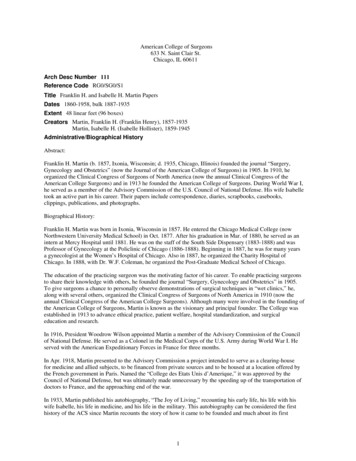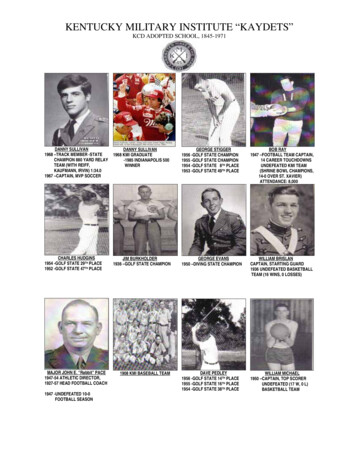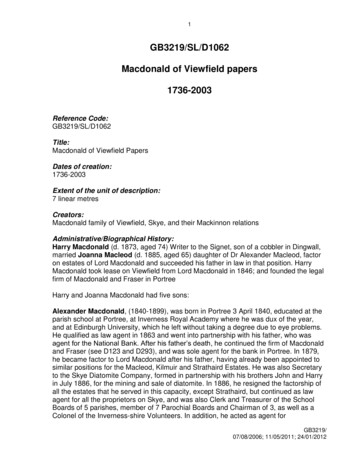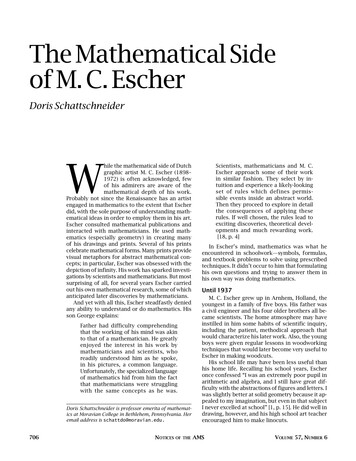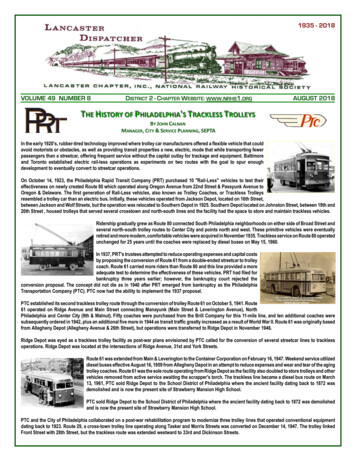
Transcription
1935 - 2018VOLUME 49 NUMBER 8DISTRICT 2 - CHAPTER WEBSITE: WWW.NRHS1.ORGAUGUST 2018THE HISTORY OF PHILADELPHIA'S TRACKLESS TROLLEYSBY JOHN CALNANMANAGER, CITY & SERVICE PLANNING, SEPTAIn the early 1920's, rubber-tired technology improved where trolley car manufacturers offered a flexible vehicle that couldavoid motorists or obstacles, as well as providing transit properties a new, electric, mode that while transporting fewerpassengers than a streetcar, offering frequent service without the capital outlay for trackage and equipment. Baltimoreand Toronto established electric rail-less operations as experiments on two routes with the goal to spur enoughdevelopment to eventually convert to streetcar operations.On October 14, 1923, the Philadelphia Rapid Transit Company (PRT) purchased 10 "Rail-Less" vehicles to test theireffectiveness on newly created Route 80 which operated along Oregon Avenue from 22nd Street & Passyunk Avenue toOregon & Delaware. The first generation of Rail-Less vehicles, also known as Trolley Coaches, or Trackless Trolleysresembled a trolley car than an electric bus. Initially, these vehicles operated from Jackson Depot, located on 16th Street,between Jackson and Wolf Streets, but the operation was relocated to Southern Depot in 1925. Southern Depot located on Johnston Street, between 19th and20th Street , housed trolleys that served several crosstown and north-south lines and the facility had the space to store and maintain trackless vehicles.Ridership gradually grew as Route 80 connected South Philadelphia neighborhoods on either side of Broad Street andseveral north-south trolley routes to Center City and points north and west. These primitive vehicles were eventuallyretired and more modern, comfortable vehicles were acquired in November 1935. Trackless service on Route 80 operatedunchanged for 25 years until the coaches were replaced by diesel buses on May 15, 1960.In 1937, PRT's trustees attempted to reduce operating expenses and capital costsby proposing the conversion of Route 61 from a double-ended streetcar to trolleycoach. Route 61 carried more riders than Route 80 and this line provided a moreadequate test to determine the effectiveness of these vehicles. PRT had filed forbankruptcy three years earlier; however, the bankruptcy court rejected theconversion proposal. The concept did not die as in 1940 after PRT emerged from bankruptcy as the PhiladelphiaTransportation Company (PTC). PTC now had the ability to implement the 1937 proposal.PTC established its second trackless trolley route through the conversion of trolley Route 61 on October 5, 1941. Route61 operated on Ridge Avenue and Main Street connecting Manayunk (Main Street & Leverington Avenue), NorthPhiladelphia and Center City (9th & Walnut). Fifty coaches were purchased from the Brill Company for this 11-mile line, and ten additional coaches weresubsequently ordered in 1942, plus an additional five more in 1944 as transit traffic greatly increased as a result of World War II. Route 61 was originally basedfrom Allegheny Depot (Allegheny Avenue & 26th Street), but operations were transferred to Ridge Depot in November 1946.Ridge Depot was eyed as a trackless trolley facility as post-war plans envisioned by PTC called for the conversion of several streetcar lines to tracklessoperations. Ridge Depot was located at the intersections of Ridge Avenue, 31st and York Streets.Route 61 was extended from Main & Leverington to the Container Corporation on February 16, 1947. Weekend service utilizeddiesel buses effective August 16, 1959 from Allegheny Depot in an attempt to reduce expenses and wear and tear of the agingtrolley coaches. Route 61 was the sole route operating from Ridge Depot as the facility also doubled to store trolleys and othervehicles removed from active service awaiting the scrapper's torch. The trackless line became a diesel bus route on March13, 1961, PTC sold Ridge Depot to the School District of Philadelphia where the ancient facility dating back to 1872 wasdemolished and is now the present site of Strawberry Mansion High School.PTC sold Ridge Depot to the School District of Philadelphia where the ancient facility dating back to 1872 was demolishedand is now the present site of Strawberry Mansion High School.PTC and the City of Philadelphia collaborated on a post-war rehabilitation program to modernize three trolley lines that operated conventional equipmentdating back to 1923. Route 29, a cross-town trolley line operating along Tasker and Morris Streets was converted on December 14, 1947. The trolley linkedFront Street with 28th Street, but the trackless route was extended westward to 33rd and Dickinson Streets.
LANCASTER DISPATCHERPAGE 2AUGUST 2018Concurrent with the Route 29 changeover from trolley to trolley coach operation, modifications were occurring with theinstallation of new overhead wire on Route 75. As a trolley, Route 75 connected the neighborhoods of Bridesburg, Frankford,Feltonville and Tioga, but on Sundays, service was extended via Route 53 to Wayne Avenue and Carpenter Lane. As a trolleycoach operation the streetcar routing remained virtually unchanged from Richmond and Orthodox Street to Wyoming Avenueand 5th Street. However, a revised route pushed the service in a westward direction crossing Roosevelt Boulevard, insteadof south then west, to offer direct public transit in underserved neighborhoods. New transfer opportunities allowed fortransfers at the Broad Street Subway's Wyoming Station and at the Wayne Junction Station terminus with other PTC bus andtrolley routes, along with Reading Railroad service. Service commenced on April 19, 1948. Brochures distributed topassengers announced the mode change regarding the trackless service and other bus route changes occurring in theFrankford section of Philadelphia.PTC's attention turned towards the conversion of Route 59, a double-ended trolley routelinking Frankford (Oxford & Frankford Avenues) and Bustleton (Bustleton Avenue & LottStreet). The City of Philadelphia financed and constructed the line, and PRT, later PTC,operated and maintained the line. Service commenced service on November 5, 1922,concurrent with the opening of elevated high-speed service to Frankford from center city.The third route, Route 59 resembled a country trolley service in its early years where in many locations a single-track operationwas utilized along portions of Castor Avenue and Bustleton Pike. Passing sidings were strategically placed to allow for safeand fast operations. The line grew in popularity as neighborhoods developed in places where farms and grassy fields werethe norm. On April 19, 1948, the trolley service was cutback from Lott Street to Cottman Avenue and a new bus Route (59b)temporarily replaced trolley service north of Cottman Avenue. PTC and the City of Philadelphia partnered in the transformationof Castor Avenue north of Cottman Avenue from trolley to trackless service and once this segment was completed the secondset of overhead wires were installed. The last remnants of rail service were discontinued as trackless service commenced onJune 25, 1950. The route was revised to utilize the Arrott Street Terminal, adjacent to the Margaret-Orthodox Elevated Stationthen follow Oxford Avenue and Castor Avenue terminating at the Bells Corner loop located near Castor and Bustleton Avenues.For the expansion of the trackless network 65 coaches were built by the Brill company in 1947 and 28 additional coaches werebought from Marmon-Harrington in 1949. Route 29 shared facilities with Route 80 at Southern Depot. Portions of FrankfordDepot were converted from rail operations to allow for storage and maintenance of the trackless fleet for Routes 59 and 75.Additional plans to further expand the trackless network were developed by PTC, but a new team of stockholders controlling PTC in the early 1950's shiftedgears and began the process of phasing out most of the streetcar network and converting to bus operations. One exception was the City of Philadelphia'sdesire to convert Route 66, operating conventional double-ended trolleys along Frankford Avenue, into a trackless route. The collaborative efforts by PTCand the City in converting Route 59 came together for the initiative to transform Route 66 to trolley coach operation. 42 coaches were purchased and placedinto service on September 11, 1955. Efforts to improve travel time were implemented on June 19, 1961 as Express service was implemented. Frankford Avenueis an extremely wide thoroughfare between Comly Street and Rhawn Street and additional set of overhead wires were installed to offer non-stop expressservice between the Bridge-Pratt Elevated Station and Cottman Avenue.The last route to switch to a trackless trolley operation was Route 79. This route operated as a double-endedstreetcar line until October 27, 1956 when buses replaced trolleys. Sometime during 1960, PTC decided to convertthe route to an electric mode as surplus trackless vehicles were available through the discontinuation of Routes61 and 80. Trackless service commenced on June 13, 1961. Route 79 operates a crosstown route along SnyderAvenue from Vare to Delaware Avenue.For the next fifty years, the trackless network of five routes remained virtually unchanged, except for a smallsegment of Route 75 that was discontinued east of Frankford Avenue in April 1966 due to the construction of I-95 through the Bridesburg neighborhood nearRichmond Street. The Brill and Marmon-Harrington coaches that were purchased between 1947 and 1955 were retired and replaced by 110 modern vehiclesbuilt by AM General beginning in 1980. Ten vehicles were equipped with wheelchair lifts. These vehicles operated nearly a quarter-century. On June 9, 2002,the Northeast Philadelphia trackless Routes 59, 66 and 75 became temporary bus routes as the reconstruction of the Frankford Elevated overhead structurenecessitated the temporary cessation of trolley coach service. Buses began to temporarily replace the aging SouthPhiladelphia trackless coaches on Route 29 concurrent with a detour as a City initiated project razed and rebuilt the TaskerHomes located near the western end of the route.Route 79 was also converted to a bus route effective September 7, 2003. Thisleft Routes 59, 66 and 75 as Trackless Trolley routes operating from FrankfordDistrict. The permanent status of Routes 29 and 79 in South Philadelphiaremains undecided.In 2007 a demonstrator trolley coach was delivered by New Flyer Industries toreplace the 1979 vehicles. In 2008, SEPTA purchased 38 low-floor vehicles which seat 39 passengers, are ADAcomplaint and provide off-wire capability for short distances utilizing a diesel engine. These vehicles replaceddiesel bus operations on Routes 59, 66 and 75. These vehicles are housed at Frankford District.
LANCASTER DISPATCHERPAGE 3AUGUST 2018THE POWER DIRECTOR“NEWS FROM THE RAILROAD WIRES”AMTRAK’S SUMMER RENEWAL IS ABOUTMORE THAN TRACK THIS YEARNEW YORK, June 22, 2018, Trains News WireAmtrak officials are waving farewell, for now,to the Spuyten Duyvil Bridge, which will berebuilt this summer and returned to service this fall to restore NewYork-area passenger rail service back to something akin to normal.Scot Naparstek, Amtrak chief operating officer, and Stephen Gardner,Amtrak’s chief commercial officer told media during Wednesday conferencecall that contractors removed the bridge and towed it away on a barge June13 for mechanical and electrical work. Officials say the bridge is expectedto be repaired and re-installed in time for re-opening of the line betweenPenn Station and the Harlem River returns to service on Sept. 3. Amtrakuses the Empire Connection, which includes the Spuyten span, for itsupstate New York service.Amtrak is seeking information on coaches, trainsets and self-propelledunits. After a review of the marketplace, Amtrak said it plans to develop andrelease a Request for Proposal for specific replacement equipment in 2019.“New equipment will provide our customers with a more modernexperience, while improving ride quality and reliability,” said Amtrak VicePresident of Corporate Planning, Byron Comati, in a release.The Amfleet I fleet underwent recent interior refurbishment including seats,carpets and lighting. The operator said replacement of the near-40-year-oldcars is more cost-effective than maintenance.“This order is part of Amtrak’s plan to refresh and replace its fleet,” itstated.Naparstek also tells media that 645 feet of the Empire Tunnel will be loweredduring the work this summer in planning for future work on the HudsonRiver Tunnels between New York and New Jersey.The enduring design of the outside-bearing Amfleet cars originated with theMetroliner EMUs built by Budd of Philadelphia in the late 1960s. Buddmanufactured a total of 642 Amfleet I cars from 1975-77, and 150 similarAmfleet II cars from 1980-83. The last intercity passenger cars built by Buddand the first locomotive-hauled cars ordered by Amtrak, Amfleet comprisedshort- and long-distance coaches, cafes, club cars, lounges, and businessclass cars, according to Wikipedia.Under Penn Station, all work on tracks 15 and 18 have been completed ontime. Work proceeds on the western third of Track 19 replacing ties andballast.There is no U.S.-based builder of intercity passenger cars; Amtrak hasrecently been taking delivery of new baggage and dining cars from asubsidiary of CAF, headquartered in Spain.In addition to below-concourse events, Gardner talked about workperformed on passenger-occupied areas including refurbishing bathrooms,installing lactation suites for nursing mothers. The balky Rotundaair-conditioning system will be restored to full operation, which was anissue this week with hot temperatures in New York City. The railroad willreceive construction bids of both Club Acela and the Amtrak ticketedwaiting rooms.Earlier in June Amtrak issued a Request for Proposals for new or rebuiltlocomotives to supplement and replace older Genesis diesels in its nationalnetwork fleet. In 2021, the first of 28 new Acela Express trainsets will beginoperating on the Northeast Corridor.The platforms at Penn Station, inadequate for the passenger loads of 2018,are also being looked at in order to make them less crowded and moreaccessible. This will be tied in with the opening of the Moynihan Station, thenew above-ground entrance to Penn Station, which Amtrak will useexclusively. The current space that it uses at Penn Station will be re-workedfor Long Island Rail Road and NJ Transit passengers, while the threeoperators will partner on the platform revitalization.ROANOKE, Va., June 26, 2018, Trains News Wire - So far, Amtrak officialsare pleased with how passengers are patronizing once a day round trips toRoanoke.The most tantalizing item was held for the end of the call. Discussing therefitting of Acela sets, and purchase of new high-speed equipment, Gardnersaid that Regional trains will not suffer. He said that Amtrak officials willlook for replacements for regional service passenger cars. These are mostlyAmfleet I coaches. While not imminent, all of the almost 500-car fleet are atleast 40 years old.Amtrak’s Summer 2018 Penn Station Infrastructure Renewal is destined tobe the start of historic transitions over the next few years, affectingdestinations far beyond New York City.AMTRAK COULD SEEK AMFLEET I REPLACEMENTSWASHINGTON, June 28, 2018, Railway Age - The end may be in sight for anaged mainstay of the national passenger car fleet.The national passenger train operator posted a Request for Information(RFI) aimed at exploring possible replacements for its Amfleet I equipment.The RFI is for single-level passenger cars used primarily on routes east ofthe Mississippi River. The tubular, stainless steel Amfleet cars were built byBudd Corp. and its descendant in the early 1980s, and are deployed onNortheast Regional, Keystone, Carolinian and Illinois service trains.AMTRAK PLEASED WITH ROANOKE RIDERSHIP ON NORTHEASTREGIONAL EXTENSIONAccording to statistics available from the Commonwealth of Virginia, 14,178boarded a once daily Northeast Regional train in Roanoke between Oct. 31and the end of April, while 13,591 people stepped off the Northeast Regionaltrain in the western Virginia city."We are pleased ridership is meeting expectations. More customers arechoosing Amtrak as it is simply the smarter way to travel," an Amtrakrepresentative tells Trains News Wire.Passenger rail service returned to the Star City for the first time in 38 yearson Oct. 31. Passengers are able to travel in and out of Roanoke from citiessuch as Washington, New York, and Boston.Local riders tell Trains News Wire boarding their train in Roanoke is awelcomed convenience. Until the new station opened, travelers would haveto make arrangements to board in Lynchburg, Va., to reach destinationsnorth for business or leisure. That meant riders returning to Lynchburgwould encounter the inconvenience of driving back to Roanoke.A local source tells us that there has been a decrease in riders boarding inLynchburg, but that is due to the increase in riders now able to begin theirjourney in Roanoke. Numbers provided by the Commonwealth do not breakdown ridership at either location.So far, ridership through Roanoke reached a high in December with 3,288passenger departing and 2,941 passengers arriving. In April, the latestmonth for which figures are available, 2,343 passengers arrived in Roanoke
LANCASTER DISPATCHERPAGE 4and 2,327 departed the city.CHICAGO UNION STATION REDEVELOPMENT DESIGNS ANNOUNCEDCHICAGO, June 26, 2018, Trains News Wire - A developer has unveiledplans for a modernistic, seven-story steel and glass addition to be built atopthe historic Chicago Union Station. The addition would provide for a hotel,apartments, offices and new retail space within the eight-story headhouse,where passengers wait for trains.Amtrak, which ownsUnion Station,s e l e c t e dChicago-basedR i v e r s i d eInvestment &Development andC o n v e x i t yProperties in May2017 to come upwith plans for theredevelopment.ANARTIST'S RENDERING OF A CHICAGO UNION STATIONREDEVELOPMENT DESIGN AS VIEWED FROM ADAMS AND CANALSTREETS IN THE CITY - RIVERSIDE INVESTMENT & DEVELOPMENTVIA AMTRAKIt’s the second timein recent years thatplans for ahotel/office/retail forUnion Station havebeen proposed. A 2002 proposal went nowhere.The new construction would still allow natural light to illuminate thestation’s Great Hall via its famed glass skylight, according to thedevelopers.Over the decades, the 219-foot-long skylight has deteriorated due to waterdamage and flaws within the original design, according to Amtrak. It isundergoing a 22 million restoration.Union Station, completed in 1925, was designed by Daniel Burnham andsuccessor firm Graham, Anderson, Probst & White.The addition would be part of a multi phase redevelopment of the entirestation and surroundings, and would not directly impact train traffic itself.Amtrak and Metra commuter train operations are housed in a Concoursebuilding across the street from the Head House and connected by a tunnel.Plans for the 1 billion project were unveiled Monday evening at a meetingin Union Station’s Burlington Room, called by the Chicago alderman inwhose ward the station is located.The plans must be approved by the Chicago City Council, but developerssay they are hopeful the project could start in spring of 2019. Amtrak’sboard must also give the go-ahead.“Amtrak supports this important step in the plan as we continue to work tobring this important project to our Board of Directors,” an Amtrakrepresentative said in a statement.John O’Donnell, the CEO of Riverside, told the meeting that the goal is tomake Union Station a seven-day-a-week, year-round “destination.”A representative for Riverside did not respond to Trains News Wire’srequests for comment Tuesday. The bold plans prompted an immediatethumbs-down from the architecture critic for the Chicago Tribune, whocalled them “utterly underwhelming.”The addition’s exterior, said Blair Kamin, “a skeletal metal and glass grid,is at odds with the station’s carefully composed classical aesthetic.“Despite the architect’s best efforts, it’s as though one era of architecturehad been piled, willy-nilly, atop another,” Kamin wrote.Kamin points out that Burnham once envisioned Union Station as amagnificent gateway to Chicago’s west loop area, and that an officeAUGUST 2018building had been originally planned for atop the station but never built,though foundations were laid.In 2002, another Chicago architect, Lucien Lagrange, previously unveileda plan for a 400-foot tower above the station, with hotel offices andapartments. That plan fizzled.AMTRAK ADDS HOT-MEAL OPTION ON LAKE SHORE, CAPITOLWASHINGTON, July 13, 2018, Trains News Wire - Amtrak is adding ahot-meal choice to lunch and dinner food service for sleeping-carpassengers on the Lake Shore Limited and Capitol Limited.PHOTO BY BOB JOHNSTON, TRAINS MAGAZINEBeginning this week,slow-braised beef shortrib in a red wine and beersauce will be added tothe lunch and dinnermenu of pre-prepareditems, which also includea vegan wrap, chickenCaesar salad, andantipasto plate. Droppedis the chilled grilled beeftenderloin salad.Breakfast service remains a single meal, featuring fruit, a muffin, a Greekyogurt parfait, and breakfast bars.“Our plan to provide fresh food choices now includes a hot option, whichis based on engaging our sleeping car customers on what they would likeand with special training for our train crews,” Bob Dorsch, vice presidentof the Amtrak Long Distance Service Line, said in a media release. “Thiscontemporary style of service has been well received by customers, withmeals of their choice and at times they choose. These customers also enjoyhaving exclusive use of the dining cars.”Amtrak replaced full-service dining cars on the two trains on June 1,replacing them with boxed meals which sleeping-car passengers can eat inthe dining room or have delivered to their room.CSX TRANSPORTATION PREPARING TORE-OPEN HUMP AT RADNOR YARD INNASHVILLEJACKSONVILLE, Fla., June 29, 2018, TrainsNews Wire - CSX Transportation will reopenthe hump at Nashville's Radnor Yard within the next few weeks.The hump was idled in July 2017 as part of the broad operational changesmade by then-CEO E. Hunter Harrison, who converted eight of CSX’s 12hump yards to flat-switching facilities last year.Flat-switching proved cumbersome at the former Louisville & Nashvilleyard, so preparation work is now under way to resume hump operations.The railroad did not have a firm date for reopening the hump, but said itwould hinge on completing necessary maintenance of retarders and otherinfrastructure at the yard.“The principles of scheduled railroading are based on the premise that wecontinuously seek opportunities to optimize the network and enhancecustomer service. Given the footprint complexities of flat switching atRadnor Yard in Nashville, we will improve network fluidity, optimize trainstarts, dramatically reduce out-of-route train miles and switching costs byreopening the hump,” a CSX spokesman says.In 2016, Radnor was CSX’s third-busiest hump – behind only Waycross, Ga.,and Selkirk, N.Y. — as it classified an average of 1,477 cars per day. That’swithin the range that Harrison said was sufficient volume to justify theoperating costs and capital expense of a hump yard.But classification volumes fluctuated systemwide as CSX changed itsoperating plan to minimize the number of times cars are handled en route.
LANCASTER DISPATCHERPAGE 5AUGUST 2018Radnor remains among CSX’s top 10 terminals in terms of volume. Therailroad would not disclose current volume levels.Overall, CSX’s costs were down 8 percent, led by a 10-percent decline inlabor expenses.When the hump reopens, CSX expects to boost employment at Radnor by40 to 50 people. Operating plan changes related to reopening the hump willreduce the number of employees at some other yards across the system, sothere will not be a net increase in yard employees overall.CSX also is working to improve its safety performance, with a new safetyofficer on board and outside consultants preparing an evaluation of itssafety program, Foote says.“As we continue to refine the operating plan in Nashville and throughoutour network, we will identify opportunities to rationalize existing yards andother infrastructure. This will allow us to continue to eliminate unnecessarysteps and drive improved service,” a CSX spokesman says.During the first three weeks of June, dwell at Radnor averaged 29.1 hours,according to reports CSX filed with the Surface Transportation Board usingstandard Association of American Railroads performance metrics. Dwellwas well within normal ranges at the yard, although it was above thesystemwide average of 20.2 hours.Radnor will be the second reversal of a hump closure at CSX.The hump was idled at Avon Yard outside Indianapolis in early August, thenreopened by the end of the month as CSX experienced widespreadcongestion and service problems due to the rapid rollout of Harrison’sPrecision Scheduled Railroading operating model.CSX executives have said they expect the railroad to setservice-measurement records for the second quarter, which ends June 30.CSX MAKES EARNINGS RECORD; CEO WANTS COMPANY TO BE THE“SAFEST RAILROAD”JACKSONVILLE, Fla., July 18, 2018, Trains News Wire - CSX Transportationset a company record for its lowest quarterly operating ratio as therailroad’s revenue rose, costs tumbled, and profits soared in the secondquarter.CSX’s operating ratio fell to 58.6 percent, an improvement of 4.9 pointscompared to the figure from a year ago, adjusted for the impact of one-timerestructuring costs. CEO Jim Foote said the operating ratio was “clearly thelowest ever for CSX and I believe the lowest ever by a U.S. railroad.”The railroad reported net earnings were up 72 percent, to 877 million, asrevenue increased 6 percent, to 3.1 billion for the quarter. Earnings pershare shot up 84 percent, to 1.01, well above Wall Street estimates of 87cents per share, thanks in part to the effects of tax reform and sharebuybacks.“Two words sum up everything: Great performance,” Foote said during theJuly 17 earnings call with investors and Wall Street analysts.CSX’s traffic was up 2 percent for the quarter, led by a 7-percent increasein coal shipments. Utility coal was down amid stiff competition from naturalgas, the railroad said, but the strong export coal market continued for bothmetallurgical and thermal coal.Intermodal traffic was up 2 percent, led by gains in international intermodal.Domestic volume was down slightly as the rationalization of low-densityintermodal moves last year more than offset growth. Merchandise trafficwas down 1 percent.The results prompted CSX to boost its revenue outlook for the rest of theyear. The railroad is now projecting revenue will increase by midsingle-digits compared to its previous forecast of up slightly.The change was a reflection of expectations for continued strong exportcoal shipments, higher fuel prices, and a healthy economic backdrop, Footesays.CSX hauled more freight with 9-percent fewer crew starts and 13 percentfewer locomotives, as well as far fewer freight cars, Chief Financial OfficerFrank Lonegro says.As a result of the smaller locomotive and freight car fleets, CSX reduced theshop craft workforce by 18 percent compared to a year ago.“We intend to be the safest railroad,” Foote says.LOOKING 50 MOVES AHEADNorfolk Southern believes that innovationand experimentation are most efficientlydriven in the laboratory of privateindustry.To that end, we support balanced, performance-based regulation that willpromote the private development of critical new technologies, enabling NSto most effectively deliver on its commitment to Reimagine Possible.In this week’s #TechTalk, we’re discussing Movement Planner, an advancedsoftware technology critical to maximizing the productivity and capacity ofNorfolk Southern’s network.Every day, NS faces a daunting challenge: designing an intricate plan toefficiently move hundreds of trains across the company’s rail system, acomplex network that spans 19,500 route miles across 22 states. EnterMovement Planner, a sophisticated logistics tool that can analyze the manydifferent train movements scheduled for a given day and create anoptimized plan for getting the job done.Like an advanced chess-playing AI, Movement Planner looks many movesinto the future to create a superior operational strategy for all of NS’ movingpieces. Perhaps even more impressive, Movement Planner updates its planevery two minutes based on the most current system data – and there’smore to come. Thanks to PTC and the precise locomotive GPS data itprovides, Movement Planner will become an even more effective tool forfuture operations.Most exciting, NS sees the potential to leverage synergies betweenMovement Planner and other technologies, such as Auto-Router, to explorethe potential for advanced automation of many dispatch functions. It’s justone more way that NS is building on the technology of today to reimaginea safer, more efficient, and reliable railroad for tomorrow.BRIGHTLINE PERMITS FOR ORLANDOEXPANSION GET OK; TAMPA IS NEXTTARGETMIAMI, July 9, 2018, Trains News Wire Highways are proving to be the Trojan horse facilitating passenger trainexpansion for Florida’s Brightline — first to Orlando, then Tampa.Last month, Orange County commissioners greenlighted an environmentalpermit allowing Brightline to begin building a 125-mph corridor through 106acres of thick brush and wetlands immediately adjacent to the BeachlineExpressway east of Orlando International Airport. The 22-mile route throughOrange County will connect with soon-to-be upgraded Florida East CoastRailway tracks at Cocoa, Fla., about 130 miles north of Brightline’s currentnorthern terminus of West Palm Beach, Fla.Orange County Mayor Teresa Jacobs told th
linking Frankford (Oxford & Frankford Avenues) and Bustleton (Bustleton Avenue & Lott Street). The City of Philadelphia financed and constructed the line, and PRT, later PTC, operated and maintained the line. Service commenced service on November 5, 1922, concurrent with the opening of elevated high-speed service to Frankford from center city.



